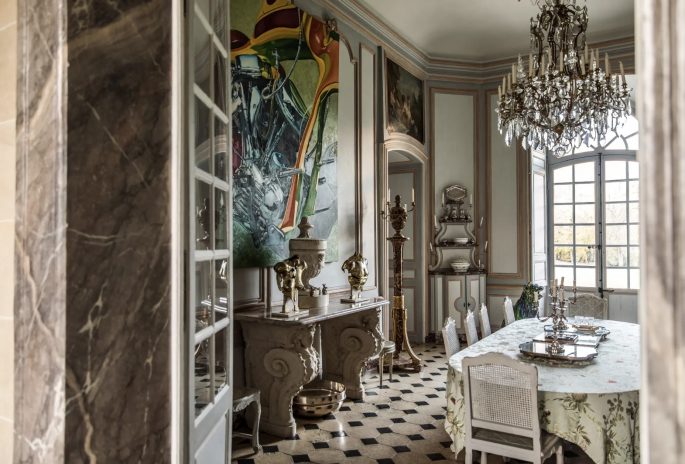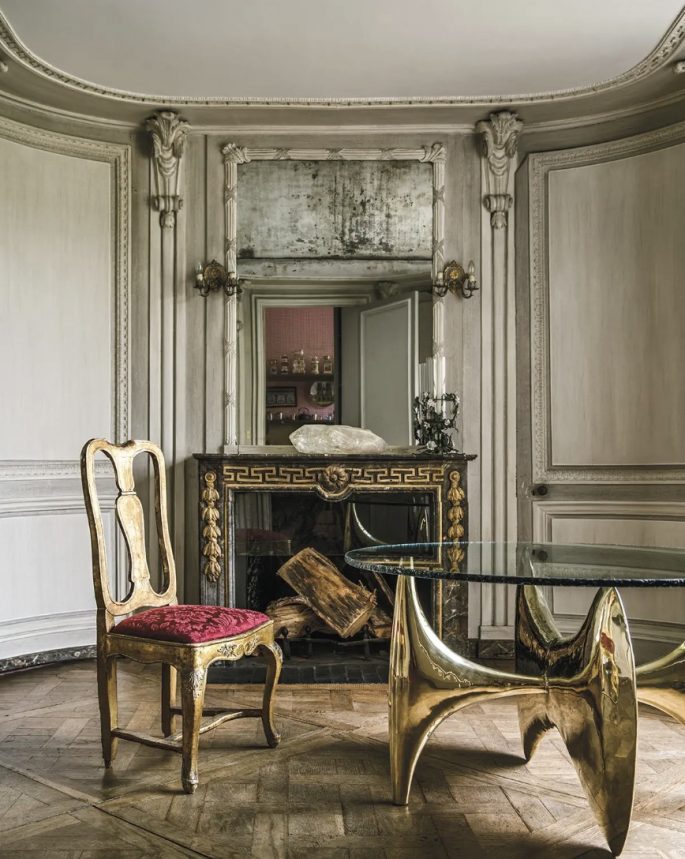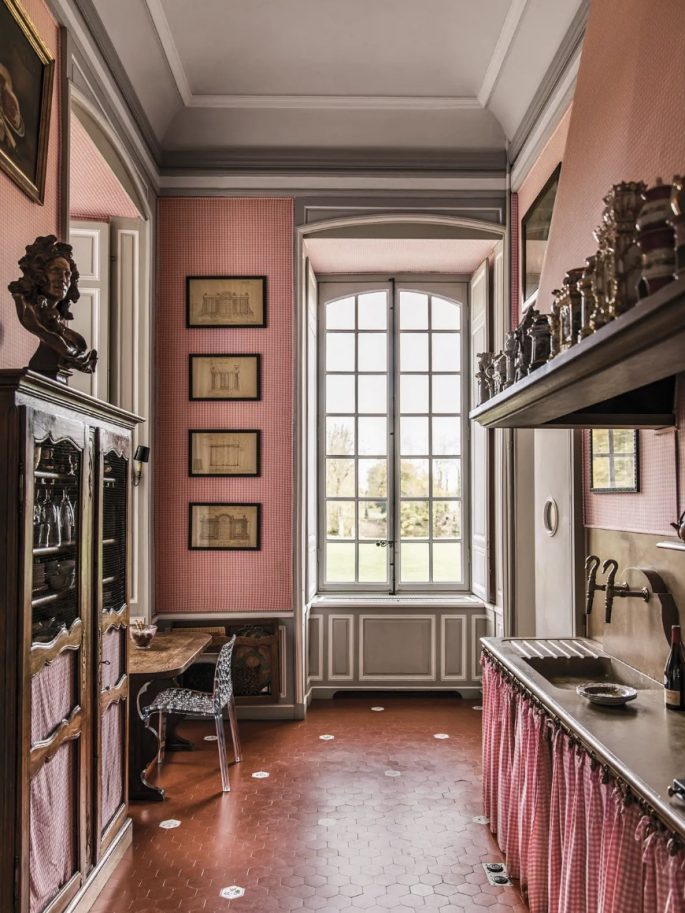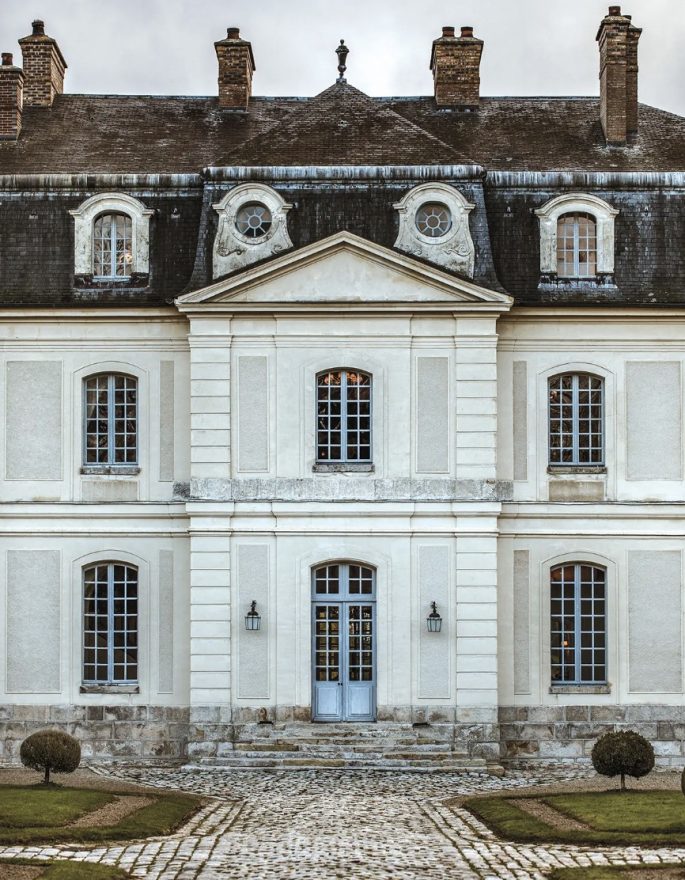Owning a Louis XV-era chateau means deciding whether to honour the past or completely upend it. But for Jean-Louis Tapiau, the solution was somewhere in the middle.
Jean-Louis Tapiau stands in the vast entryway of his inherited chateau outside of Paris, dressed in a trim black corduroy suit, ready to give a tour. At first glance, the scene seems like a straightforward fantasy: a grand Louis XV-era legacy perfectly preserved in amber. Château d’Aunoy, 31 miles southeast from the city, is among the most elegant and well-maintained of the country’s remaining Baroque mansions, with 22 rooms over 8,600 square feet on 175 acres. The house, built from 1750 to 1754, is surrounded by the remarkable gardens envisioned by its second owner, the renowned 18th-century lawyer Pierre Jean-Baptiste Gerbier, among the first in France to employ the formal English style.
But in fact the chateau’s narrative — and its current owner’s — turns out to be more complex than it originally appears, just like the idiosyncratic rooms inside. Tapiau, 56, has been battered by deaths, disillusionment and divorce, events that have in turn shaped his answers to the questions that always arise for those who inherit an important old house: How much of the past should be respected? What if staying entirely faithful to what came before ultimately makes the place feel like a cage? Tapiau has chosen to respond boldly, transforming the interiors into a daring pastiche of high design and lingering legacy, from the Rococo to the contemporary avant-garde. Look closely and Château d’Aunoy can be read as a lavish antidote to personal suffering, a primer on how to use the layers of time as a salve for all that’s broken.
“When I lost so much, it was a big opportunity for me to create something new and beautiful,” he says, “but at the time, I did not see it. I only see it now, 10 years later.”

In the dining room, Tom Blackwell’s “Rainbow 74” (1969-70) and a pair of bronze busts by the sculptor Francisco Méndez look over a French Régence-period marble console. Photo by Martin Morrell
At the beginning, it was all lightness on a magnificent scale.
Tapiau’s father, Jacques, who had built a scrap-metal and recycling empire, bought the house in the late 1970s, when his son, an only child, was a teenager. The chateau had been through about a dozen former owners, the most recent of whom were Emmanuel and Maria Motte. Emmanuel was once a decorator for Maison Jansen, the fabled Parisian design company founded in 1880 and known for meshing Classical motifs with Modernist touches; over his 25 years at Château d’Aunoy, he added such flourishes as a vast ceiling mural modeled on the Galerie des Glaces at Versailles. When Tapiau’s parents took over, his mother, Rolande — an aspiring actress with an eye for dramatic detail — kept much of Motte’s work while putting her mark on the interiors, including the master bedroom with its all-encompassing floral print and en suite bathroom with invisible taps.
After Tapiau finished university, he settled in Paris to become, perhaps unsurprisingly, a dealer of 18th-century antiques.
But on Christmas Day of 1999, when he was 37, came the first in a series of misfortunes that would tie him intimately to Château d’Aunoy and foretell its reimagining: A hurricane tore through the city and the surrounding countryside, ravaging the Bois de Boulogne and the park of Versailles. Château d’Aunoy’s grounds became a chaotic tangle of felled trees. The storm turned out to be the first squall of Tapiau’s own tempest; soon after, his mother was diagnosed with cancer. Through her illness, her son oversaw the restoration of the grounds, installing thousands of trees, many of them the same beeches, oaks, hornbeams and maples that had originally thrived there. These years brought a few bright moments for Tapiau (including the birth of his twin daughters), but mostly there was darkness: His mother’s death was followed by the demise of his father a couple of years after he had signed over the chateau to Tapiau in 2007. Around that same time, his marriage fell apart.

In the oval room, a 1970s table by Philippe Hiquily, an 18th-century Venetian chair and a fireplace of Saint Anne marble. Photo by Martin Morrell
Afterward, Tapiau began spending most of his time at Château d’Aunoy. As he contemplated what to do with the seemingly endless space, he turned to Yves Gastou, a gallerist who had helped him furnish his former Parisian apartment — a 19th-century hôtel particulier — from Gastou’s eponymous shop in Saint-Germain-des-Prés. Like Tapiau, the animated Gastou, now 71, had grown up steeped in the 18th century; his father had worked for an auction house. He knew the era’s charms and its limitations. But instead of remaining immersed in the past, Gastou moved omnivorously through the 20th century. His gallery freely mixed periods and cultures: the polished curves of the Italian midcentury master Gio Ponti alongside the simple lines of the contemporary British lighting designer Tom Dixon; the refined elegance of the eccentric architect Carlo Mollino with the industrial edge of the Japanese furniture designer Shiro Kuramata.
Gastou and Tapiau shared a desire to mesh a historic sensibility with contemporary pieces to create a modern sense of the Rococo.
One of Tapiau’s first purchases for the home in Paris had been a pair of fluorescent-hued acrylic sculptures by Jean-Claude Farhi; he began to see the world anew when he placed them in front of the 19th-century oak boiserie in his living room.

With its terracotta floors and an 18th-century bust atop a Louis XV armoire, the homey kitchen retains its old-world charm. Photo by Martin Morrell via T Magazine, NY Times.
At the chateau, he and the Gastous (the gallerist works with his 36-year-old son, Victor) aimed to establish a lively dialogue between old and new. Tapiau sees the process as a continuation of “the conversation that Henri Samuel started,” referring to the legendary decorator who, like Motte, had worked for Maison Jansen, and had been dubbed a master of “progressive historicism” after creating wildly eclectic homes for Valentino Garavani and Marie-Hélène and Guy de Rothschild.
The decade long undertaking has been both intellectual and therapeutic.
Tapiau found joy in repairing the parquet floors and black-and-white cabochon, in re-sourcing ornate wall coverings and repainting rooms in their original hues. He kept his mother’s bedroom largely as it was. Yet adding outré works to the public areas electrified him, creating not merely a new identity for the chateau but also for himself. In a small second dining room, for instance, Tapiau preserved Motte’s blue-and-white porcelain plates on the Vichy pink fabric wall but brought in a massive round table by Ado Chale, designed in the ’90s as an aluminum ode to the moon. In the entry hall, near a wall hung with imposing marble medallions mounted by another long-ago owner, each carved with the face of a different Roman emperor, there now stands a 1990 sculpture by the French New Realist artist Sacha Sosno; called “Tête Carrée” (Square Head), it is a six-foot-tall bust on a pedestal with a hyper-realistic neck that morphs into a giant, faceless block.

In one of the guest rooms, Zuber wallpaper installed by Tapiau’s mother in the ’80s, a console by Jacques Duval-Brasseur and a Maison Jansen mirror. Photo by Martin Morrell
Perhaps the ultimate expression of Tapiau’s approach can be seen in the 700-square-foot grand salon. Beneath the restored ceiling mural and antique Louis XV chandeliers, Tapiau has placed a red velvet-upholstered Louis XV sofa by Jean-Baptiste Tilliard alongside a monumental contemporary slate table by Emmanuel Jonckers and hammered bronze chairs by the French artist Philippe Hiquily. Farhi’s acrylic sculptures from Tapiau’s Paris apartment now flank the castle’s 18th-century marble fireplace like twin lava lamps. The tableaus, says Tapiau, are ever-evolving. No room is ever quite finished. But the cacophonous energy has, paradoxically, brought him the serenity he thought he might never again have.
“I had lost everything, including my own identity,” he says, “but as I invested more and more time here, I started rediscovering a sense of self.”

By adding anachronistic touches to Château d’Aunoy, the former antiques dealer Jean-Louis Tapiau has suffused the grand house — and himself — with new energy. Here, the castle’s 18th-century limestone facade. Photo by Martin Morrell
This story is an excerpt from the NYTimes Style Magazine.


